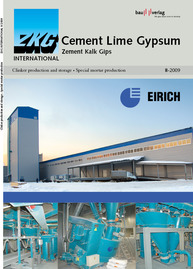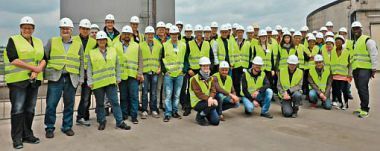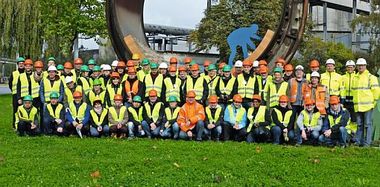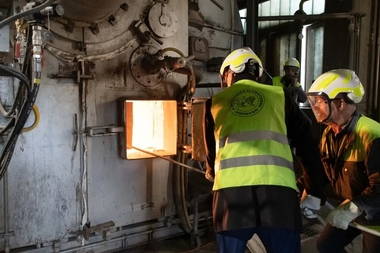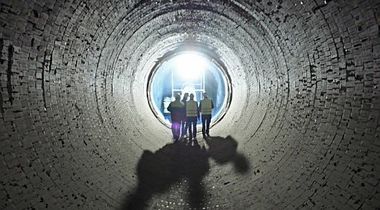The country needs engineers
ZKG Technical Excursion 2009, Ennigerloh/Germany (04.–05.06.2009)
Video: International Recruiting Heidelbergcement
“For the seventh month in succession the labour market in April 2009 showed a decline in job offers for engineers as a result of the overall economic situation. However, the unfilled vacancies calculated at approximately 64000 jobs still remains at a high level”, said Dr. Willi Fuchs, VDI director, in the Ingenieurmonitor issue May 2009. It is expected that the demand for engineers will further increase after the financial crisis has eased off, not least because of the age structure at many companies, which will then face an generation change. Thus, it is worthwhile to bring together future engineers, machinery suppliers and plant operators. Therefore, the journal ZKG INTERNATIONAL (cement, lime, gypsum) took this opportunity and invited students from the fields “process engineering, mineral processing and mineral smelting science” at the RWTH Aachen (college of advanced technology) to visit a cement plant. With a predicted global cement consumption of 2.8 billion tons of cement in 2010, the cement industry is an important and attractive industry, which is continuosly growing, with a high standard in all fields of mechanical, chemical and thermal process engineering. With this event, links could be forged between theory and practice for engineering students and the very special field of process engineering and mechanical engineering will be opened up to them.
The cement plant Ennigerloh of HeidelbergCement was the host. The plant manager Stephan Wehning (Fig. 1) introduced the participants to cement making in a very clear and fascinating way. Since his explanations were based on his own experience, the over 30 students who attended were able to form a lively impression of cement making. This was proved by the animated discussion following the lecture. Especially the students who had already finished the basic course could understand the lecture topics quite well, which was proved by their many interesting and detailed questions (Fig. 2).
In addition to
the presentation by HeidelbergCement AG as a group and the explanation of the essential steps of cement making, the introductory lecture was primarily intended to prepare for the excursions through the plant that followed the corresponding lectures. They were divided into two parts. In the first part of the plant tour, an oveview was given and the kiln line was visited. The second part consisted of the cement grinding plant, the packing plant, the dispatching and a detailed insight into plant components.
However, not only the point of view of the operator was made accessible to the students. Altogether, four cement plant specialists explained in detail the development of plant engineering and the important key functions of the production process.
Dr. Dietmar Schulz, manager of research and development at Polysius AG in Beckum/Germany, presented the central core of a cement plant in his lecture “Clinker burning – fundamentals and technology”. He explained in detail the function and mode of operation of the preheater, kiln and cooler as plant components. In this way, the students were able to understand the differences in the design of the modular calciner system Prepol® depending on the raw materials and fuels available. Furthermore, the function of a bypass was explained. It is used to extract alkali-chlorides from the gas phase at the kiln inlet. Schulz very clearly explained the possibilities for controlling the flame of the burner as well as the mode of operation of the Polytrack cooler. The individual plant sections were demonstrated using the example of Yamaver 5 from Yamama Saudi Cement, a plant that had just been erected.
The Dipl.-Geol. Norbert Streit from KHD Humboldt Wedag GmbH discussed a highly topical issue in his lecture “The use of secondary fuels for cement making – impacts on the process – technical solutions”. After an introduction to the various kinds of secondary fuels and their corresponding gross calorific values, Streit explained the connection between the various different fuels and the technical solutions for precalciner and kiln. In particular he dealt with the combustion chamber, which had been developed especially for the homogenous combustion of secondary fuels. In order to be able to use a great number of fuels with different physical properties, the multi-channel burner has gained acceptance. At the end of the lecture various case studies were presented to show the profitability of the use of secondary fuels.
The afternoon of the first day of the excursion was used for plant tours (Fig. 3–14). 178 employees are working at the Ennigerloh Nord plant that also includes the central laboratory and the sales department as well as the civil consulting office. In addition, 19 apprentices are trained there in various professions.
Ennigerloh is located in the Beckum Basin, the rocks of which belong to the Campanian (Upper Cretaceous) from the geological point of view. They were deposited about 80 million years ago. The quarrying height varies between 8 and 16 m. The material is quarried by ripping. In the case of larger heights it is blasted. The average content of CaCO3 amounts to 72 %. About 23 to 25 % of the material are extracted in the Warstein quarry, i. e. lime with approx. 97 % of CaCO3, to produce the kiln meal. Up to 1.2 million t of limestone per year are extracted at Ennigerloh. The extraction of a further 17.45 million t has already been approved. There is a reserve of another 18 million t that has not been approved for quarrying so far. The limestone transport to the crusher as well as the handling of the overburden are carried out by outside companies.
The limestone is carried to a single-rotor hammer crusher (capacity 500 t/h) by a heavy lorry specially manufactured for Ennigerloh. This crusher is also the end of the railway line of 80 km length supplying the already mentioned limestone from Warstein. The raw material is processed in two hammer mills and a downstream single-compartment ball mill from Hirschmann with a grinding capacity of approx. 250 t/h. The raw material is dried by kiln waste gases during the grinding process.
The rotary kiln plant with a rotating length of 108 m includes a 4-stage, two-string preheater and a planetary cooler and has a designed capacity of 3500 t/h. The present capacity varies between approx. 2800 and 3000 t/d. The portion of secondary fuel amounts to >70 %. Complete tyres are fed into the feed end housing. Due to the raw material characteristics it is not necessary to add iron ore. Pulverized coal and lignite are used as fossil fuels. After the cement has been produced in ball mills and connected separators, it is bagged by an 8-spout ROTO-Packer or is dispatched as bulk material at 13 truck loading points and one railway loading point. Regular sampling and analyses with the Polysius automation sytem POLAB ensure the cement quality.
Both during the lectures and plant tours the students took great advantage of the opportunity to ask questions to get a more complete picture of this professional field. In the evening the participants of the excursion became acquainted with another technical production process. Before they had a well-earned dinner at the brewery restaurant Pott’s Naturpark Brauerei in Oelde, a brewery tour was on the agenda – and also here there were a lot of enthusiastic questions. During a pleasant get-
together there was an animated exchange of ideas between the representatives of the companies and the invited students.
The second day of the excursion included two lectures and the second part of the plant tour. Dipl.-Ing. Frank Dardemann from Loesche GmbH presented the Loesche grinding technology. After a detailed description of the mode of operation of mills and of the modular system of Loesche mills, he explained the various possibilities to use mills in a cement factory. Finally, Dardemann presented the hot gas generator, which produces hot gases to dry bulk materials. This technology is, for example, used in the cement industry, in power plants, in the steel or wood processing industries.
The graduated mining engineer Harald Merker gave a lecture on “Refractory materials from Refratechnik – a high-tech product for the cement industry”. After the iron and steel production with 68 %, the cement industry with 7 % has the second highest consumption of refractory products. However, the Refratechnik group sells 85 % of their refractory products to the cement industry and only 15 % to the steel industry. Consequently, they offer many products particularly developed for the cement industry. The increasing use of secondary fuels, which due to chloride attacks act rather aggressively on the refractory lining, is a challenge for the development of new material mixtures. The priority targets for further development are: the increase of resistance to infiltration, the reduction of permeability to gas, maintainance of elasticity in the case of changing temperatures as well as increase in strength. Finally, Merker described the impact of certain materials on the refractory lining and talked about the current business of the Refratechnik group as well as the latest projects to be implemented.
In the afternoon the students had the opportunity to take a closer look at the technical equipment of a cement plant described in the lectures during the second part of the plant tour. Of course, again here there was enough time to answer the many interested questions.
Then the students returned to Aachen by bus. They will go back to their studies with an abundance of new impressions and information. Perhaps they will discover new perspectives for their future professional careers.

